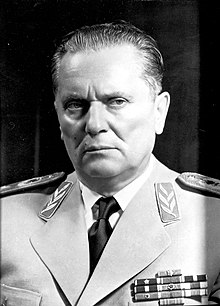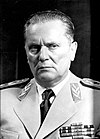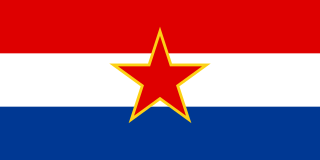
The Socialist Republic of Croatia, commonly abbreviated as SR Croatia and referred to as simply Croatia, was a constituent republic and federated state of the Socialist Federal Republic of Yugoslavia. By its constitution, modern-day Croatia is its direct continuation.
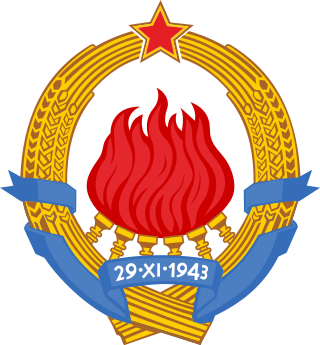
The president of the Federal Executive Council was the head of government of the Socialist Federal Republic of Yugoslavia, from the adoption of the 1963 constitution until the complete breakup of the country in 1992. Most non-Yugoslav sources referred to the post as "Prime Minister."

The prime minister of Yugoslavia was the head of government of the Yugoslav state, from the creation of the Kingdom of Serbs, Croats and Slovenes in 1918 until the breakup of the Socialist Federal Republic of Yugoslavia in 1992.
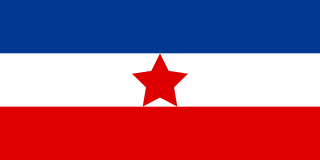
The National Committee for the Liberation of Yugoslavia, also known as the Yugoslav Committee of National Liberation, was the World War II provisional executive body of the Democratic Federal Yugoslavia, established on 29 November 1943 by the Yugoslav Partisans, a resistance movement and military arm of the Communist Party of Yugoslavia, led by Josip Broz Tito; in opposition to the London-based Yugoslav government-in-exile, headed by King Peter II.

The office of the president of the Presidency of the Socialist Federal Republic of Yugoslavia existed from the death of the President of the Republic Josip Broz Tito on 4 May 1980 until the dissolution of the country by 1992.

The Museum of Yugoslavia is a public history museum in Belgrade, the capital of Serbia. It chronicles the period of Kingdom of Yugoslavia and Socialist Yugoslavia as well as the life of Josip Broz Tito. Tito's grave is located in one of the museum buildings.

The Provisional Government of the Democratic Federal Yugoslavia was Democratic Federal Yugoslavia's temporary national government formed through the merger of the Yugoslav government-in-exile and the National Committee for the Liberation of Yugoslavia (NKOJ). It existed from 7 March to 11 November 1945. It then became the Federal People's Republic of Yugoslavia in late 1945, which in turn became the Socialist Federal Republic of Yugoslavia from 1963 to 1992.

Avdo Humo was a Yugoslav and Bosnian communist politician, writer and an Order of the People's Hero recipient.

The 1946 Yugoslav Constitution, officially titled as the Constitution of the Federal People's Republic of Yugoslavia, was the first constitution of the Federal People's Republic of Yugoslavia. It was adopted by the Constitutional Assembly of Yugoslavia, elected on 11 November 1945. Constitution came into effect at its promulgation, on 31 January 1946.

The 1974 Yugoslav Constitution was the fourth and final constitution of the Socialist Federal Republic of Yugoslavia. It came into effect on 21 February 1974.
Dušan Bilandžić was a Croatian historian and politician.

The Federal Executive Council was the executive body of the Socialist Federal Republic of Yugoslavia (SFRY) responsible for state affairs and for supervising the implementation of laws. It consisted of up to 15 members elected by the Federal Assembly for a four-year term and the presidents of executive councils of republics and provinces. The Federal Executive Council played an important role in the Government of the SFRY from its creation in 1953 until the breakup of Yugoslavia in 1992.

The office of vice president of the Socialist Federal Republic of Yugoslavia existed from April 1963 to June 1967. It was established by the new Yugoslav Constitution adopted on 7 April 1963. The first to serve in the role was Aleksandar Ranković who assumed office on 30 June 1963. Due to an affair involving wire-tapping of Yugoslav president and general secretary of the League of Communists Josip Broz Tito, Ranković was forced to resign from the Central Committee and from the vice presidency on 1 July 1966. He was subsequently replaced by Koča Popović two weeks later who served out the remainder of Ranković's four-year term. On 26 April 1967 new amendments to the 1963 constitution were approved which disestablished the vice presidency once Ranković and Popović's combined four-year term was up. The office ceased to exist on 30 June 1967.

The office of the vice president of the Presidency of the SFR Yugoslavia existed from the enactment of constitutional amendments establishing the position in 1971 until the dissolution of the country by 1992. A collective presidency existed in Yugoslavia since amendments to the constitution in 1971. The amendments established the roles of President and Vice President within the collective Presidency which would rotate between individual republics and provinces on an annual basis. However, it also defined a separate title of President of the Republic which could be conferred by the Federal Assembly into Josip Broz Tito who would automatically preside over the Presidency as well. Therefore, the launch of the Vice Presidency of the Presidency in 1971 would be the first to carry out a rotation system. Krste Crvenkovski of SR Macedonia was the first to hold the office. The subsequent order after SR Macedonia was SR Bosnia and Herzegovina, SR Slovenia, SR Serbia, SR Croatia, SR Montenegro, SAP Vojvodina, and SAP Kosovo. In 1974 a new Constitution was adopted which reaffirmed the collective federal presidency consisting of representatives of the six republics, the two autonomous provinces within Serbia and the President of the League of Communists.

The office of the president of the presidency of the Socialist Republic of Serbia existed from its establishment in the 1974 constitution to its renaming and then total abolishment as part of democratic reforms in 1990.
The Socialist Republic of Croatia, one of the constituent countries of the Socialist Federal Republic of Yugoslavia had gone through a number of phases in its political life, during which its major political characteristics changed - its name, its top level leadership and ultimately its political organization.

United Kingdom–Yugoslavia relations were historical foreign relations between United Kingdom and former Yugoslavia. Relations between United Kingdom and independent South Slavic states developed before creation of Yugoslavia following the decline of the Ottoman Empire.
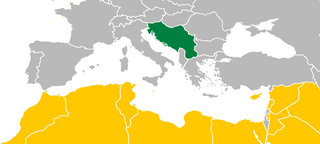
The 1987 Mediterranean Non-Aligned Countries Ministerial Meeting held on Brijuni Islands, SR Croatia, SFR Yugoslavia was the second ministerial meeting of the Non-Aligned countries from the Mediterranean region. The meeting restricted the number of participating countries exclusively to the few Non-Aligned nations of the Mediterranean area and as such focused primarily on regional issues. At the time of the meeting the group included Southern Mediterranean and Levantine Arab countries and only three European Non-Aligned countries of Malta, Cyprus and SFR Yugoslavia.


